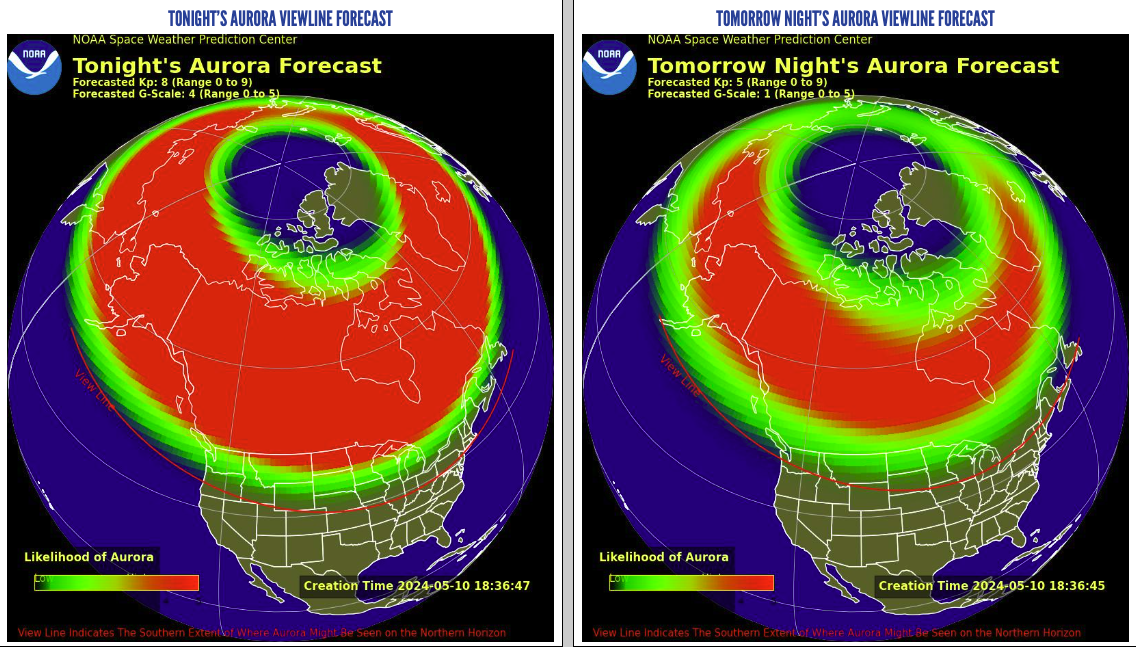Strongest solar storm since 2005 to hit Earth tonight: Will it disrupt power and communications?
(NEXSTAR) – For the first time since 2005, Earth is bracing to be hit by a powerful, G4 geomagnetic storm. NOAA’s Space Weather Prediction Center (SWPC) expects the arrival of at least five coronal mass ejections — or CMEs — as soon as Friday evening.
The SWPC rates the strength of solar storms on a G scale, from G1 to G5. There have been a few weak G4s already this year (which have created stunning aurora borealis displays), but the last time a “significant” G4 happened was in January 2005.
“Severe levels is pretty extraordinary,” Shawn Dahl, service coordinator at SWPC, said in a media briefing Friday. “It’s a very rare event to happen.”
The sun spot cluster observed is 16 times the diameter of Earth — “the largest we’ve seen in quite some time,” Dahl added.
How will the solar storm impact Earth’s infrastructure?
At the strong G4 level, impacts on our infrastructure are possible. When the CMEs (which are basically explosions of plasma and magnetic material from the sun) reach Earth, they carry with them their own magnetic field, explained Robert Steenburgh, a space scientist at SWPC.
“When you superimpose that over long conductors, things like pipelines, and railroad tracks and power lines, it can induce current — and that’s electrical current that’s not supposed to be there,” he said.
The interference could cause issues with the power grid, radio communications and the accuracy of GPS.
There shouldn’t be major issues with ATMs, cell phones or other technology people depend upon — unless power outages occur, which would obviously affect your ability to use plugged-in devices and home internet.
The good news, explained SWPC’s experts, is that the grid is better than it was in 2005, and utilities operators have made upgrades to prepare for space weather events. The early notification they have this time around also allows them to prepare and respond quickly.
When will the solar event start, and how long will it last?
Space weather forecasters can’t pinpoint an exact time when the CMEs will hit Earth, but they expect it to start Friday evening. Dahl gave a rough prediction of 8 p.m. Eastern Daylight Time, but emphasized that could be off by several hours.
They’ll have a better idea when the CMEs arrive 1 million miles from Earth. That will give a 20- to 45-minute lead time before disruptions start.
The show won’t be over Friday night, the SWPC experts said. CMEs could continue, as could their impacts, through the weekend and into early next week.
Where will northern lights be visible?
Even if you don’t notice technology issues, much of the U.S. has a good shot of seeing the northern lights this weekend.
The SWPC said Friday visibility could extend as far south as Alabama and Northern California.
Maps created by space weather forecasters show a more conservative line of visibility (seen cutting across the U.S. in a red line below) for Friday’s event (on the left) and Saturday’s (on the right).
The further North you are, the better shot you have at seeing northern lights. But Southerners shouldn’t give up hope.
“With some of the recent events, we’ve seen them as far as south Texas and even down to Central America,” said Michael Bettwy, SWPC’s operations chief.

If you’re having trouble seeing the aurora with the naked eye, Bettwy advised pointing your phone camera up at the sky. Their lenses are more sensitive to light than our eyes.
Copyright 2023 Nexstar Media Inc. All rights reserved. This material may not be published, broadcast, rewritten, or redistributed. Regular the hill posts








